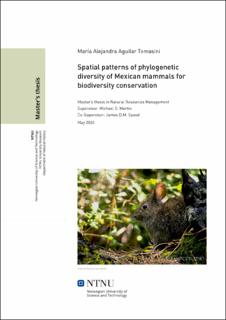| dc.description.abstract | Phylogenetic diversity (PD) is a biodiversity measurement that describes the total amount of evolutionary history contained by the taxonomic units in a particular region. PD has proven to be an important metric for determining conservation priorities, especially when the potential conservation area is small. Mammalian PD patterns have been suggested as potential surrogates of biodiversity for establishing priority areas to ensure the conservation of mammalian evolutionary diversity and of the other species with which they have co-evolved. Mexico is considered a megadiverse country, and it is one of world’s richest in mammal species. This project aims to identify the areas of high mammalian phylogenetic diversity in Mexico and to assess if current protected areas in Mexico conserve this evolutionary diversity. Distribution data for 488 Mexican mammals were obtained from IUCN and used to estimate species richness based on a presence/absence grid with 10x10-km cells. Molecular data for these species was gathered from GenBank and from laboratory extractions and further sequencing of three molecular markers (cytB, 12S and COI), which were used to reconstruct a maximum-likelihood phylogenetic tree. Diversity analyses were conducted in R by importing both the distribution data sets and the phylogenetic tree. PD was calculated by summing the branch lengths of the phylogenetic tree representing species presence in each cell of the grid. These results were compared to the map of Mexican protected areas (PAs) in order to quantify the proportion of evolutionary history that is effectively conserved. Patterns of PD and SR are similar and highly correlated, with the southeastern part of Mexico being the most highly diverse, likely because of its highly productive ecosystems and the higher abundance of chiropteran groups in southern areas. PAs conserve most of the mammalian SR and all the PD at the genus level. PAs can be divided into areas containing high levels of mammalian diversity and areas with low levels of it. This division may result from the many endemic species that occur in the country as well as the presence of PAs on islands. beta-diversity analyses showed that the species composition between PAs and the rest of the country is very similar and that differences between the two of them are mainly due to species missing from the other sites rather than species missing from the PAs. Focusing conservation actions with PD can be useful when resources are limited as it allows conservation of the overall evolutionary history of a group, even though individual species may not be protected if they are closely related to others. We recommend further work on population viability within PAs, as well as the predicted effect of future climate change on PD patterns, in order to assess the effectiveness of PA in conserving the Mexican mammal community. | |
